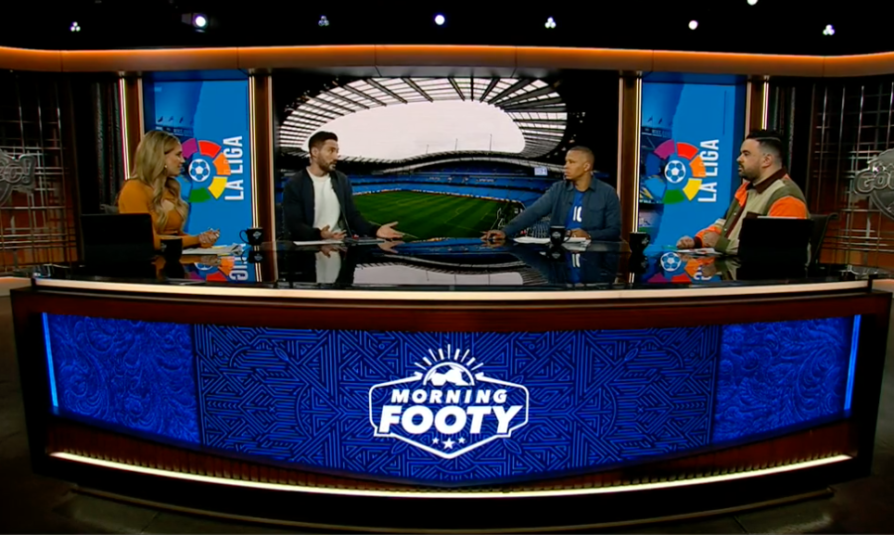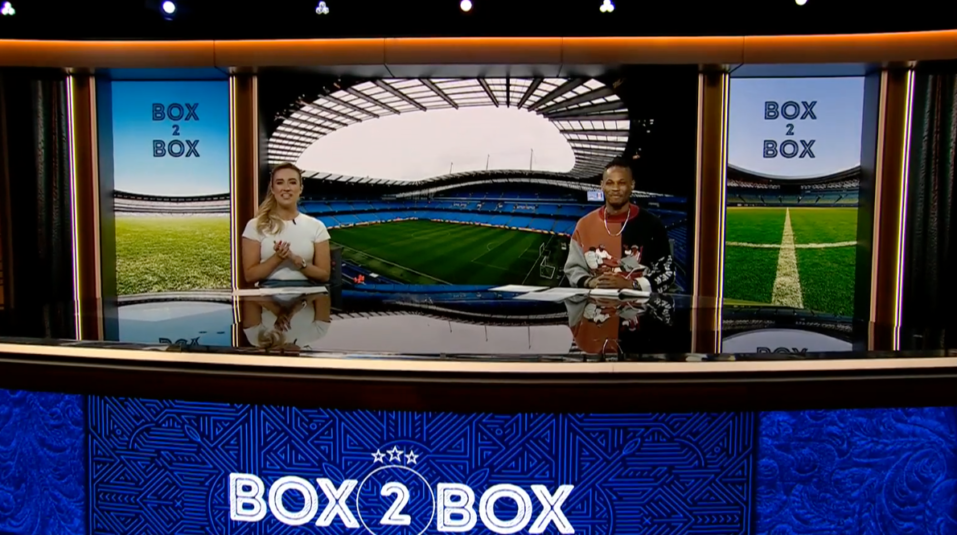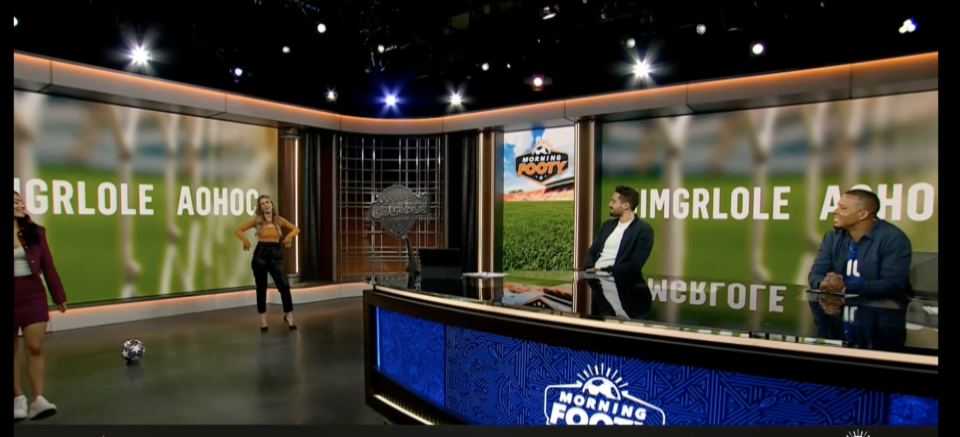CBS Sports Goes All-In on Cloud for Launch of Golazo Network
Contribution, master control, playout, distribution, and more are all handled in the cloud
Story Highlights
The launch of the CBS Sports Golazo Network today marks not only one of the biggest swings in the history of soccer programming but also one of the biggest cloud deployments in the history of broadcasting. All switching, routing, recording, clipping, and distribution is being done entirely in an AWS cloud environment for the 24-hour direct-to-consumer streaming network, which is dedicated entirely to domestic and international soccer coverage.
“Everything is actually built in the cloud in terms of the network playout,” says Corey Smith, senior director, advanced production technologies, CBS Sports. “The only thing we’re [producing] live from outside the cloud are our desk shows coming from Ft. Lauderdale or Stamford or CBS Broadcast Center — or it could be anywhere else in the world. Our cloud-based infrastructure can pull in all the external feeds coming in and route them logically — just like you would in a fixed facility but removing the dependency on a physical facility — to package all of the broadcasts. It’s quite the machine we’ve built.”
System Overview: GV AMPP, AWS Play Key Roles
Golazo Network’s cloud-based ecosystem is based on Grass Valley’s GV AMPP (Agile Media Processing Platform) and has been built out across multiple AWS instances. GV AMPP handles all playout, recording, routing, and switching from its broadcast facilities, and Net Insight NIMBRA manages all routing of SRT feeds within the cloud. Other key vendors are OpenDrives for cloud-based storage, and EEG’s Lexi encoders for automated captioning. The ticker is supplied by a set of servers in Dublin routing over NDI into playout and keyed in cloud.

CBS Sports Golazo Network’s Morning Footy debuted this morning, featuring (from left) Susannah Collins, Charlie Davies, Nico Cantor, and Alexis Guerreros.
“We’re truly embarking on a new mission where we’re not allowing physical constraints to dictate what feeds we get and who we get them from,” says Smith. “The biggest challenge is how to globally scale this. How do we bring up environments in a blue/red network design just like you would for a traditional high-profile television network? You need to make sure you have zero points of failure, everything’s redundant, and things are all backed up.”
The primary AWS data center for the Golazo Network operation is in Virginia, which is close to CBS Sports Digital’s studios in Stamford, CT, and Ft. Lauderdale, FL, as well as the CBS Broadcast Center in New York. In total, the ecosystem comprises five AWS regions: Virginia, Dublin, Frankfurt, Oregon, and Sao Paulo.
Inside each environment, several layers of technology are deployed. The primary regions for AMPP are Oregon, Virginia, Dublin, and Sao Paulo — the last also serving as a hub for Paramount Global’s Latin American operations in Argentina and Brazil. All recording infrastructure is run out of Virginia, Oregon, and Dublin; the playout systems come out of Virginia and Oregon. Asset-management nodes are in Virginia, Dublin, Oregon, and Sao Paulo. Net Insight NIMBRA infrastructure is deployed in all five regions.
“It’s a fairly crazy undertaking to put this much switching, routing, and recording capability in cloud,” says Smith. “I don’t know that that I’ve seen anybody else doing this — at least not at this scale.”
Since all infrastructure is in the cloud, all operators for the Golazo Network are able to work remotely. Currently, master-control operators are located in Tennessee, Philadelphia, Texas, Mississippi, Colorado, and other places.
Recording, Storage, MAM: OpenDrives and GV AMPP Elastic Recorder
One of the biggest challenges CBS Sports faced was figuring out how to deploy enough storage in the environment to record all the feeds — including all live matches and studio shows — for re-airing later. CBS Sports opted to deploy a model in which three regions have OpenDrives storage built in the cloud. Each environment has roughly 500 TB of storage, totaling 1½ PB of cloud storage across the three regions.
Those regions are equipped with a GV AMPP Elastic Recorder, providing 40 channels of live-recording capacity. The asset-management layer indexes the content based on storage location and makes it available to all playout nodes and the operators in master control to clip the content for playout.
“It’s a very complex mesh of storage locations,” says Smith. “Every box can reach every storage region, and every storage region is accessible to every box that it needs access to. When we’re doing a primary and a backup record, we may be recording into Virginia as primary and into Dublin as secondary. We always have a backup file copy somewhere on the network. If we lose Virginia, for example, we can still bring those files back to our playout nodes in Oregon. We’re actively redundant on multiple layers.”
OpenDrives helped solve a key issue for CBS Sports when constructing the ecosystem: AWS doesn’t have the functionality to do live read/write on S3 until the file is closed. 0
“We needed to be able to take the assets coming into the system and subclip them so we can roll it to playout,” says Smith. “As we are clipping content internally, we can basically drag those clip assets directly from asset management into the playlist as we’re building our 24-hour program schedule throughout the course of the day.”
Contribution, Routing, Switching, Captioning: GV AMPP, Net Insight NIMBRA, and EEG Lexi
Contribution paths come into the cloud environment from several sources: the physical CBS Sports Digital studios in Ft. Lauderdale and Stamford (which enter the system via AWS Direct Connect) and European match feeds (all coming in as SRT feeds).
“Since we have our primary operations in the cloud, we could put a desk show in L.A. or Latin America or Europe at the drop of a hat,” says Smith. “We’re flexible enough that we can bring feeds in from anywhere in the world to contribute to the network.”
Once these feeds are in the ecosystem, Net Insight routing infrastructure routes them to the appropriate master-control switcher, and then they pass through the AMPP infrastructure to playout or Elastic Recorder.
“We essentially take what NIMBRA is from a hardware-based perspective on DTM (Dynamic Synchronous Transfer Mode) network and bring it into the cloud,” says Smith. “That allows us to have any number of different inputs and outputs in the system. We can pretty much bring any of the paths in that we need and then push everything back out because every input and output in the network is available on this router. Whether it’s going to AMPP, to playout, or to Elastic Record, it doesn’t really matter: everything is completely switchable on our network.”
Once the final program feed comes out of the playout network, it goes back through the Net Insight routing infrastructure and then is captioned via EEG’s Lexi encoders, which use AI for transcriptionist-less captioning. The broadcast exits the ecosystem and is distributed to CBSSports.com, the CBS Sports app for connected-TV devices, the CBS Sports mobile app, Pluto TV, and Paramount+.
“The way we’ve set up this environment, we have true multi-pronged distribution,” says Smith. “In the past, a lot of cloud infrastructure was point-to-point, where you have a specific source and a specific destination and you can’t alter what happens to that broadcast stream in between. Essentially, NIMBRA is giving us that core router you would have a [physical] facility in the cloud.
“We have almost infinite scale,” he continues, “assuming our partner downstream has the capacity to provide that traffic I/O. We can spin up SRT paths infinitely, as opposed to contacting the local telco at the facility and having more local loops dropped in, which is a big undertaking.”
Launch Day and Looking Ahead: Morning Footy, Box 2 Box, Man City-Bayer Munich
Golazo Network officially went live this morning with Morning Footy, the network’s flagship morning show at 7 a.m. ET and Box 2 Box at 1 p.m. The afternoon features an exclusive special-edition UEFA Champions League prematch show, a live tactical cam for Manchester City-Bayern Munich, and multiple network-exclusive postmatch shows. Beginning at 7 p.m., the network will re-air CBS Sports’ UEFA Champions League coverage, including both quarterfinal matches.
Programming at launch also includes simulcasts of Calcio e Cappuccino (CBS Sports’ Serie A studio show), magazine shows, and Paramount+’s Stories From the Beautiful Game soccer-documentary collection.
“We’re not done yet. We still have lots of other aspirations,” says Smith. “But I’m extremely humbled to be a part of such an amazing team. The team at CBS gave us an end goal, which was to launch the Golazo Network, and then gave us the flexibility to go off and do what we need to without dictating to us how it should be done. Cloud is new, and there’s not a lot of people doing this at our scale. I’m extremely proud of the progress that our entire team has made and of how they jumped into the deep end of the pool in terms of cloud.”


